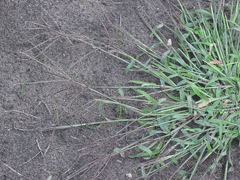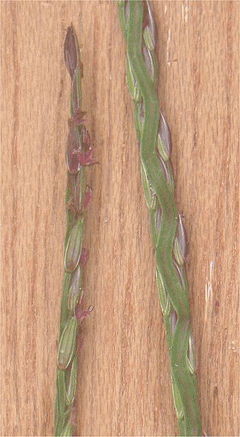 |
|
http://commons.wikimedia.org/wiki/User:Rasbak |
 |
| http://commons.wikimedia.org/wiki/User:Rasbak |
Translate this page:
Summary
Main Bloom Time: Early fall, Late fall, Mid fall. Form: Spreading or horizontal.
Physical Characteristics

 Digitaria sanguinalis is a ANNUAL growing to 0.5 m (1ft 8in) at a fast rate.
Digitaria sanguinalis is a ANNUAL growing to 0.5 m (1ft 8in) at a fast rate.
See above for USDA hardiness. It is hardy to UK zone 7. It is in flower from August to September. The species is hermaphrodite (has both male and female organs) and is pollinated by Wind.
Suitable for: light (sandy) and medium (loamy) soils. Suitable pH: mildly acid, neutral and basic (mildly alkaline) soils. It cannot grow in the shade. It prefers moist soil.
UK Hardiness Map
US Hardiness Map
Synonyms
Panicum sanguinale.
Plant Habitats
Cultivated Beds;
Edible Uses
Edible Parts: Seed
Edible Uses:
Seed - ground up and used as a flour[2, 57, 105]. It has excellent keeping qualities[74] and makes a fine white flour that can be used for semolina[74, 115].
References More on Edible Uses
Medicinal Uses
Plants For A Future can not take any responsibility for any adverse effects from the use of plants. Always seek advice from a professional before using a plant medicinally.
Emetic Ophthalmic VD
A decoction of the plant is used in the treatment of gonorrhoea[218]. A folk remedy for cataracts and debility, it is also said to be emetic[178, 218].
References More on Medicinal Uses
The Bookshop: Edible Plant Books
Our Latest books on Perennial Plants For Food Forests and Permaculture Gardens in paperback or digital formats.

Edible Tropical Plants
Food Forest Plants for Hotter Conditions: 250+ Plants For Tropical Food Forests & Permaculture Gardens.
More

Edible Temperate Plants
Plants for Your Food Forest: 500 Plants for Temperate Food Forests & Permaculture Gardens.
More

More Books
PFAF have eight books available in paperback and digital formats. Browse the shop for more information.
Shop Now
Other Uses
Fodder Paper
A fibre obtained from the plant is used in making paper[74]. Animals: Fodder/animal feed,
Forage.
Special Uses
References More on Other Uses
Cultivation details
Prefers a sandy soil[50]. Requires a warm sheltered position[162]. This species is occasionally cultivated, especially in Poland, for its edible seed. Special Features:
Invasive.
References Carbon Farming Information and Carbon Sequestration Information
Temperature Converter
Type a value in the Celsius field to convert the value to Fahrenheit:
Fahrenheit:
The PFAF Bookshop
Plants For A Future have a number of books available in paperback and digital form. Book titles include Edible Plants, Edible Perennials, Edible Trees,Edible Shrubs, Woodland Gardening, and Temperate Food Forest Plants. Our new book is Food Forest Plants For Hotter Conditions (Tropical and Sub-Tropical).
Shop Now
Plant Propagation
Seed - best sown in situ in the spring[162]. Only just cover the seed.
Other Names
If available other names are mentioned here
crabgrass. hairy crabgrass, hairy finger-grass, large crabgrass, crab finger grass, purple crabgrass. Spanish: alpiste cimar (Honduras); frente de toro (Honduras); fresadilla (Honduras); garrachuelo; pasto de cuaresma (Argentina); pendejuelo (Nicaragua); sombrillitas (Honduras); zacate digitaria (Honduras); zacate pata de gallina (Honduras). French: manne terrestre; panic sanguin; sanguinette. Portuguese: milha-digitada. Argentina: pasto colchón, pasto cuaresma. Brazil: milha-de-pendao. France: Digitaire sanguine. Germany: Bluthirse; Fingerhirse, Blutrote. Italy: sanguinella. Netherlands: Bloedgierst. Spain: pata de gallina.
Native Range
TEMPERATE ASIA: Saudi Arabia, Afghanistan, Cyprus, Egypt (Sinai), Iran, Iraq, Israel, Jordan, Lebanon, Syria, Turkey, Russian Federation-Ciscaucasia (Ciscaucasia), Armenia, Azerbaijan, Georgia, Russian Federation (Dagestan), Kazakhstan (south), Kyrgyzstan, Turkmenistan, Uzbekistan, China (Anhui Sheng, Gansu Sheng, Hebei Sheng, Henan Sheng, Shaanxi Sheng, Shandong Sheng, Sichuan Sheng, Xinjiang Uygur Zizhiqu, Xizang Zizhiqu) TROPICAL ASIA: India, Nepal, Pakistan EUROPE: Hungary, Slovakia, Russian Federation (European part), Belarus, Moldova, Russian Federation (Kalmykija, Respublika, Astrakhan, Saratov, Volgogradskaja oblast), Ukraine (incl. Krym), Albania, Bulgaria, Greece, Croatia, Italy (incl. Sardinia, Sicily), Romania, Slovenia, Spain (incl. Baleares), France, Portugal AFRICA: Spain (Canarias), Algeria, Egypt, Libya, Morocco, Tunisia
Weed Potential
Right plant wrong place. We are currently updating this section.
Please note that a plant may be invasive in one area but may not in your area so it's worth checking.
D. sanguinalis is a noxious weed particularly common in maize, beet, vegetable crops, orchards and vineyards. It is one of the major weeds found in early-sown rice. It is also found on waste ground, railway embankments, neglected lawns and grassy ridges [1d].
Conservation Status
IUCN Red List of Threatened Plants Status : This taxon has not yet been assessed.

Growth: S = slow M = medium F = fast. Soil: L = light (sandy) M = medium H = heavy (clay). pH: A = acid N = neutral B = basic (alkaline). Shade: F = full shade S = semi-shade N = no shade. Moisture: D = dry M = Moist We = wet Wa = water.
Now available:
Food Forest Plants for Mediterranean Conditions
350+ Perennial Plants For Mediterranean and Drier Food Forests and Permaculture Gardens.
[Paperback and eBook]
This is the third in Plants For A Future's series of plant guides for food forests tailored to
specific climate zones. Following volumes on temperate and tropical ecosystems, this book focuses
on species suited to Mediterranean conditions—regions with hot, dry summers and cool, wet winters,
often facing the added challenge of climate change.
Read More
Expert comment
Author
(L.)Scop.
Botanical References
50200
Links / References
For a list of references used on this page please go here
Readers comment